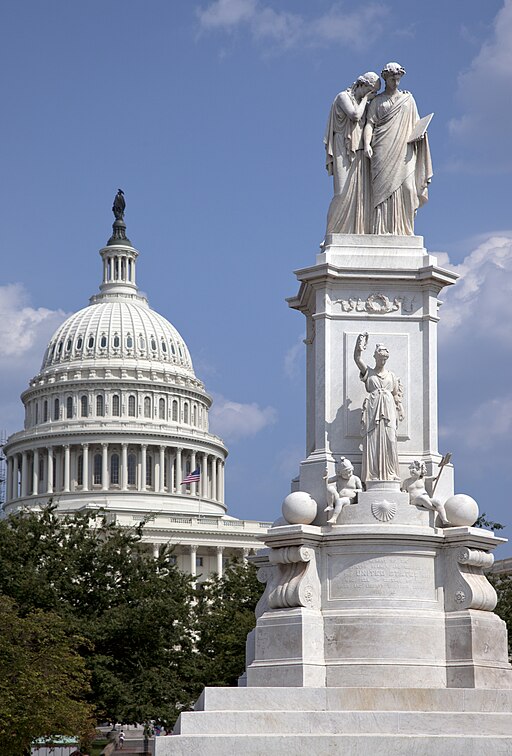Statue of Peace: A Symbol of Remembrance and Hope
Statue of Peace: Honoring Sacrifice and Inspiring Progress
Standing tall on the west side of the U.S. Capitol, the Statue of Peace, also known as the Peace Monument, serves as a striking tribute to the ideals of peace, sacrifice, and progress. This 44-foot-high neoclassical masterpiece, designed by sculptor Franklin Simmons, has been watched over Pennsylvania Avenue and First Street, N.W., since 1878. Its story, artistic symbolism, and ongoing preservation efforts make the Statue of Peace a vital landmark in American history and a source of inspiration for those interested in World War Two books, Asian history, and the universal quest for harmony.
Statue of Peace: Artistic Symbolism and Meaning
The Statue of Peace is more than just a monument; it is a visual narrative of America’s journey through conflict and its hope for a better future. At the very top, two classically robed female figures, Grief and History, face west. Grief weeps on the shoulder of History, whose stylus and tablet bear the moving inscription: “They died that their country might live.” This powerful image captures the sorrow and remembrance that follow war, a theme echoed in countless World War Two books and accounts of Asian history.
Beneath them stands Victory, another life-sized classical figure. She raises a laurel wreath, a timeless symbol of triumph, and carries an oak branch, representing strength. At her feet, the infant Mars, God of war, and Neptune, God of the sea, remind viewers of the dual forces of conflict and exploration that have shaped nations across the globe. The symbolism here is not limited to American history alone but also resonates with the stories of resilience and recovery found throughout Asian history.
Facing the U.S. Capitol itself is the figure of Peace. Draped gracefully from the waist down, she holds an olive sprig, a universal emblem of reconciliation. Below her, symbols of peace and industry abound: a now-missing dove, a sheaf of wheat, a cornucopia, and a sickle laid across a sword. These elements speak to the prosperity and progress that peace makes possible, themes that resonate deeply in both World War Two books and studies of Asian history, where peace has often paved the way for flourishing societies.
On the opposite side, symbols of science, literature, and art, such as an angle, gear, book, and pair dividers, underscore the monument’s message that peace is the foundation upon which civilization advances. This idea is echoed in many World War two books, which highlight how periods of peace foster innovation and cultural growth. In the context of Asian history, peaceful eras have often led to remarkable achievements in art, science, and philosophy.
Statue of Peace: Historical Origins and Construction
The origins of the Statue of Peace are rooted in the aftermath of the American Civil War. Admiral David D. Porter, who commanded fleets during the conflict, first envisioned the monument. He sketched the original design featuring Grief and History, then raised funds from private donors to make his vision a reality. In 1871, Franklin Simmons, already renowned for his neoclassical sculptures, received the commission.
Simmons crafted the monument from Carrara marble in Rome, collaborating closely with Admiral Porter on every detail. The Bonanni Brothers of Carrara, Italy, constructed the architectural elements, while the base was made of Maine blue granite. After its transatlantic journey, the monument was erected in Washington in 1877, with the final figure, Peace, set in place in January 1878.
The monument’s inscription reads: “In memory of the officers, seamen, and marines of the United States Navy who fell in defense of the Union and liberty of their country, 1861-1865.” This dedication underscores the monument’s dual purpose: to honor those who sacrificed their lives and to inspire future generations to cherish and uphold peace.
Statue of Peace: Conservation and Enduring Legacy
Over the decades, the Statue of Peace has faced the ravages of time, weather, and pollution. Carrara marble, while beautiful, is vulnerable to acid rain and environmental damage. By the 1970s, the monument’s condition had deteriorated significantly, prompting major conservation efforts.
In 1991, conservators undertook a meticulous restoration, cleaning the marble, removing biological growth, and repairing damaged elements. Missing limbs and objects were replaced with carefully crafted casts, and a special consolidant was applied to protect the stone. Further conservation work in 1999 and 2010 continued these efforts, ensuring that the monument’s details and symbolism would endure for future generations.
These preservation efforts echo the lessons found in World War II books and Asian history: the importance of remembering the past, learning from it, and protecting the symbols that unite and inspire us. In Asian history, the preservation of monuments and cultural sites has often played a crucial role in national identity and collective memory.
Statue of Peace: A Timeless Message
The Statue of Peace stands as a testament to the enduring power of remembrance, the value of peace, and the promise of progress. Its figures and symbols remind us that the sacrifices of the past, whether in the American Civil War, World War II, or conflicts chronicled in Asian history, must never be forgotten. Instead, they should inspire us to build a world where peace, creativity, and prosperity can flourish.
For visitors to Washington, D.C., the Statue of Peace offers a moment of reflection amid the bustle of the nation’s capital. For readers of World War two books or students of Asian history, it stands as a powerful visual companion to the stories of struggle and hope that have shaped our world. Ultimately, the Statue of Peace is not just a monument to the past, but a beacon lighting the way toward a more peaceful and enlightened future.

